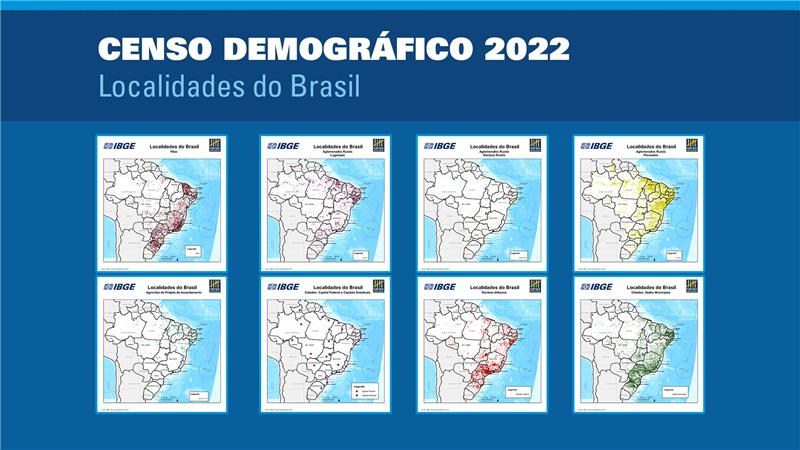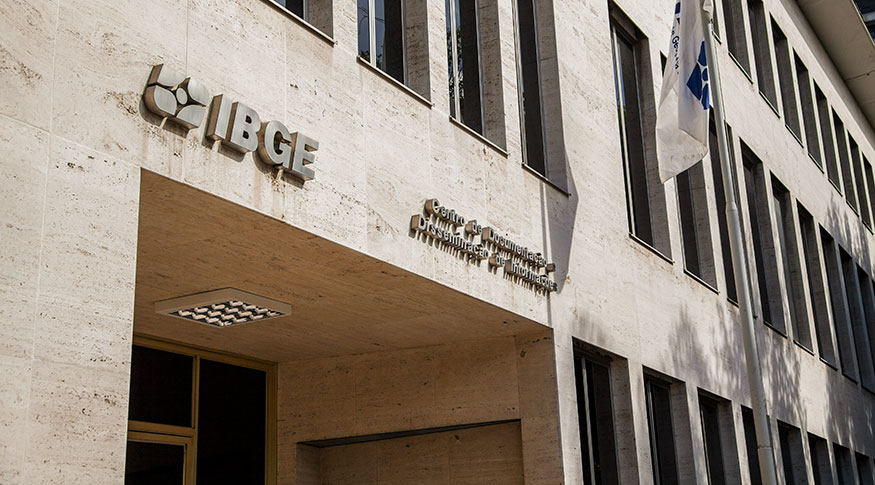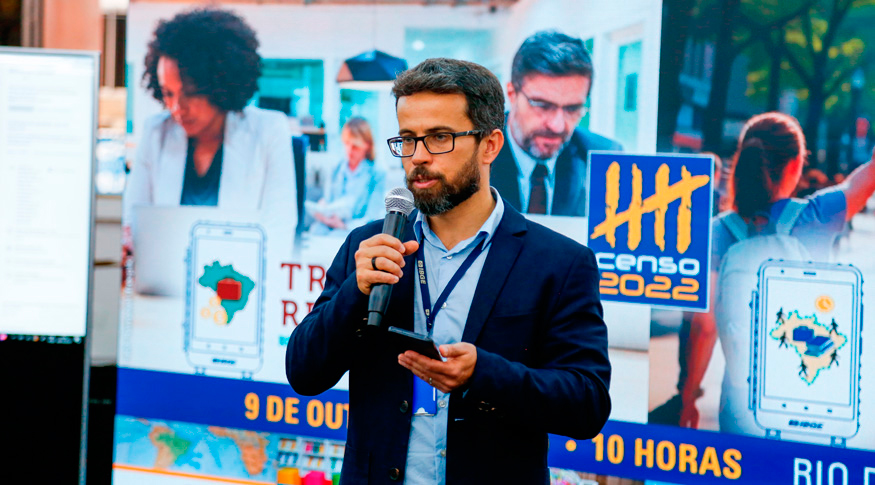PAIC
In 2022, employment in construction industry grows 4.4%, specialized services gain share in value of works of sector
May 29, 2024 10h00 AM | Last Updated: June 03, 2024 04h46 PM
Highlights
- In 2022, Brazil had 174.7 thousand construction companies, which employed 2.3 million persons. Compared with 2021, the number of companies grew 17.9%, the biggest change since 2013, and the number of employed persons increased 4.4%.
- The value produced in incorporations, works and/or construction services by the construction sector reached R$439.0 billion in nominal terms, being R$415.6 billion in works and/or services and R$23.5 billion in incorporations.
- Of the R$415.6 billion in works and services, 69.8% came from physical persons and/or private entities (R$290.1 billion) and the remaining (R$125.5 billion) from public entities.
- After four consecutive years of drops, the public sector registered an increase of 4.1 pp in the share of the total value of works in 2022. Nevertheless, it lost space in ten years, changing from 33.7% of share in 2013 to 30.2% in 2022, highlighted by Infrastructure works, which lost 4.4 pp in the period.
- In nominal terms, the value of works in the three segments were: Building construction, with R$186.1 billion in value (42.4%); Infrastructure works, with R$147.8 billion (33.7%); and Specialized services for construction, with R$105.1 billion (23.9%).
- In ten years, the construction sector lost 650.4 thousand jobs (-21.9%), mainly due to the drop in jobs in the construction of buildings, which cut 367.9 thousand employed persons (-29.9%).
- The workforce ranking showed changes in positions: Infrastructure works (29.5%) changed from the second to the third place, whereas Specialized services for construction (33.2%) got closer to the segment of Construction of buildings, the major employer along the period (37.2%).
- In relation to the pre-pandemic period, the construction sector increased employment in every year since 2019, accumulating an increase of 411.6 thousand persons, which corresponds to a growth of 21.6%.
- The total salaries, withdrawals and other compensation paid by Construction was 79.6 billion, highlighted by the sector of Works and infrastructure, with 35.1% of this value.
- The monthly average salary of Construction stayed at 2.2 minimum wages, a slight recovery against 2021 (2.1 minimum wages).
- The concentration in the sector decreased: in 2013, the eight largest companies produced 10.1% of the value of works in the sector, a percentage that fell to 3.5% in 2022, the lowest value in the time series.
- The ranking of the Federation Units in the value of works produced changed, with the following highlights: Rio de Janeiro lost the second position to Minas Gerais; Pernambuco fell from the fifth to the eleventh position, whereas Paraná changed from the seventh to the fourth position.
- Construction of buildings was the major segment in 16 Federation Units, whereas Infrastructure works prevailed in 11 of them.

The construction industry produced R$439.0 billion in value of incorporations, works and/or services in 2022, being R$415.6 billion in works and/or services and R$23.5 billion in incorporations. In 2022, Brazil had 174.7 thousand construction companies, which employed 2.3 million persons. Compared with 2021, the number of companies grew 17.9%, the biggest change since 2013, and employed personnel, 4.4%. The data are from the Annual Survey of Construction Industry - PAIC 2022, released today, 29, by the IBGE.

Marcelo Miranda, an analyst of the survey, highlights the major points of the macroeconomic scenario in 2022, a year in which the Brazilian economic scenario was marked by a series of challenges and turmoil. The Covid-19 pandemic continued to exert significant impacts, both in terms of public health and in the economy. In spite of the advances in terms of vaccination and containment measures, Brazil still faced uncertainties concerning the full recovery of a number of sectors.
“The construction industry performed a key role in this scenario. With the gradual upturn of the economic activities and as the demand for housing remained stable, the segment showed a resilience, contributing to the generation of jobs and leveraging other related sectors, like construction material and infrastructure. However, persistent challenges like high inflation and the volatility of input prices affected the productive chain of construction. The increase in the prices of materials like steel, cement and wood pressed the construction costs, making projects more expensive with an impact on final consumers,” analyzes Miranda.
In the face of this scenario, incentive measures and public policies aimed at civil construction had a relevant role. Investments in infrastructure, housing programs and tax incentives contributed to boost the sector, leveraging the economic growth. “Therefore, the link between the Brazilian economic scenario and the construction sector in 2022 was marked by integrated policies and strategies aiming at strengthening the real estate market and the national infrastructure,” completes the analyst of the survey.
Specialized services for construction grew 6.5 percentage points since 2013
Despite the loss in the share (0.8 pp) in the value of incorporations, works and/or services in ten years in 2022, PAIC showed that building construction remained as the most important segment in the sector, with 42.4% of the total value (R$186.1 billion). This segment also had the highest number of employed persons (862.8 thousand) and it was the second segment in terms of payment of salaries, withdrawals and other compensation (R$26.9 billion).
Infrastructure works was the second one in terms of value of works and services, with 33.7% (R$147.8 billion), though it lost 5.7 pp in share in ten years. This segment employed 684.7 thousand persons and paid R$28.0 billion in salaries, withdrawals and other compensation, the highest value in the construction industry.
Although it is the third one in terms of value of works and services, the segment of Specialized services for construction, with a share of 23.9% (R$105.1 billion), grew 6.5 pp since 2013 and took the second position in number of employed persons (770.3 thousand persons), paying R$24.7 billion in salaries, withdrawals and other compensation.
“Since the beginning of the time series, Specialized services for construction was the segment that got the highest gains (absolute and percentage) in employed personnel, with an increase of 441.6 thousand persons or 134.4%,” highlights Miranda.
In ten years, construction industry lost 21.9% of job positions
PAIC 2022 shows that construction companies employed 2.3 million persons, a reduction of 21.9% (-650.4 thousand employed persons) over 2013. Along ten years of analysis, employment in the three segments suffered significant changes. Despite the reduction of 4.3 pp in share in employed personnel in the segment of Building construction, it remained as the major employer of the construction sector in 2022. The segment of Infrastructure works fell from the second to the third position, with a reduction of 2.9 pp, standing behind Specialized services for construction, which gained a position by improving the share in the number of employed persons by 7.1 pp.

Between 2021 and 2022, number of persons employed in construction grew 4.4%
In relation to 2021, the amount of 2.3 million employed persons represented a rise of 4.4% (more 98.6 thousand workers), mainly leveraged, in absolute terms, by the segment of Building construction, with an increase of 45.1 thousand employed persons. The three segments gained: Building construction grew 5.5%, Infrastructure works, 5.6%, and Specialized services for construction, 2.3%.
In relation to the pre-pandemic period, the construction sector increased employment in every year since 2019, accumulating an increase of 411.6 thousand persons, which corresponds to a growth of 21.6%.
In terms of compensation value, measured in minimum wages (s.m.), Infrastructure works paid the highest salary (2.6 s.m.), above the average salary of 2.2 s.m. and above the salaries paid by the segments of Building construction and Specialized services for construction, both with 2.0 s.m.
Private sector is the major contractor of construction works and services
Among the structural changes in the construction industry, the growth in the share of the private sector as the contractor of works and/or construction services hit 69.8% of the total value of works and services. The share of the public sector (30.2%) as contractor dropped 3.5 pp between 2013 and 2022. Infrastructure works led this movement (-4.4 pp), whereas the share in Building construction and Specialized services for construction remained virtually stable in ten years.
“After four consecutive years of drops in the annual comparison, the share of the public sector rose 4.1 pp as a contractor in 2022. The three segment contributed to this, with Building construction, Infrastructure works and Specialized services for construction increasing their shares in 3.3 pp, 6.2 pp and 0.9 pp, respectively, between 2021 and 2022,” highlights the PAIC analyst.
Concentration is the lowest one in the time series
In 2013, the eight largest companies represented 10.1% of the value of incorporations, works and/or construction services, a percentage that dropped to 3.5% in 2022. This reduction in the R8 indicator was mainly influenced by the drop in this indicator in Infrastructure works, which also obtained the lowest value in the time series in 2022 (6.8%), which corresponds to a decrease of 18.8 pp in ten years.
The segment of Building construction registered a slight positive change from 6.8% to 6.9% in ten years. On the other hand, the segment of Specialized services for construction increased in concentration, changing from 4.8% in 2013 to 6.0% in 2022.
Building construction was the segment with the highest work value in most FUs
Concerning the structure of the construction industry in the Brazilian Major Regions, Building construction was the major segment in 16 Federation Units, whereas Infrastructure works prevailed in 11 of them.
Once again, the Southeast had the largest share in the value of works and services in 2022, despite the reduction in the share over the last ten years, from 52.3% to 49.5%.
Between 2013 and 2022, the South Region recorded the biggest increase in share in the total value of works and services (4.5 pp), hitting 16.7%. In spite of this rise, it ranked as the third region in Brazil. Despite the drop of 1.1 pp in ten years, the Northeast Region remained in the second place in the regional ranking, hitting 18.3% of share in the total value of works and services. Although the share of the Central-West Region increased 0.4 pp and the North Region reduced 0.9 pp, these regions also maintained their positions with shares of 9.5% and 6.1% in the total value of works and services, respectively.
Southeast concentrates nearly half of the persons employed in construction
Persons employed in construction companies by Major Region did not significantly change. The Southeast (49.9%) remained as the biggest employer, followed by the Northeast (19.7%), South (15.8%), Central-West (8.8%) and North (5.7%). The South and Southeast regions significantly increased their share in the national figure, growing 2.6 pp and 2.5 pp, respectively, in the last ten years. The Central-West grew 0.2 pp, whereas the Northeast lost 3.5 pp and the North, 1.9 pp in the period.

São Paulo remained leading in value of incorporations, works and/or construction services
After losing 10.0 pp between 2013 and 2022, Rio de Janeiro (14.2%) dropped to the third position among the most relevant states in the Southeast in terms of value of work and services. Minas Gerais ranked in the second position, hitting a share of 26.7%, an increase of 7.9 pp in the same period. São Paulo remains with the largest share at the regional and national levels. It closed 2022 with a share of 55.2% in the Southeast Region, an increase of 1.7 pp since 2013.
“Between 2013 and 2022, São Paulo remained as the major Federation Unit in value of incorporations, works and/or construction services. Rio de Janeiro lost the second position to Minas Gerais. The drop in Pernambuco (from the fifth to the 11th position), the increase in Paraná (from the seventh to the fourth position) and in Santa Catarina (from the tenth to the seventh position) create awareness,” notes the analyst of the survey.
Ranked earlier in the first position in the South Region, Rio Grande do Sul (31.7%) had its share reduced by 7.5 pp, losing the leadership to Paraná, with a share of 38.2% in the total value of incorporations, works and/or construction services. Even increasing 5.0 pp along the same period, Santa Catarina (30.1%) remained in the third position.
More about the survey
The Annual Survey of Construction Industry (PAIC) is an important source of statistical information on the business segment of construction in Brazil. The major variables covered by the survey are: employment and salaries; revenue, costs and expenditure; value of incorporations, works and/or construction services; types of works and/or construction services; and construction products. PAIC brings data for Brazil, Major Regions and Federation Units.



















